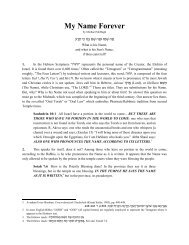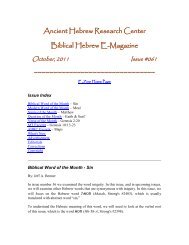Dating the Book of Job (PDF) - Ancient Hebrew Research Center
Dating the Book of Job (PDF) - Ancient Hebrew Research Center
Dating the Book of Job (PDF) - Ancient Hebrew Research Center
You also want an ePaper? Increase the reach of your titles
YUMPU automatically turns print PDFs into web optimized ePapers that Google loves.
<strong>Dating</strong> <strong>the</strong> <strong>Book</strong> <strong>of</strong> <strong>Job</strong> 11<br />
6. The <strong>Hebrew</strong> wording which describes Jochebed – Amram’s wife – is peculiar and can be<br />
interpreted to mean that she was adopted into <strong>the</strong> family <strong>of</strong> Levi and hence that Amram may<br />
have married into <strong>the</strong> family <strong>of</strong> Levi. (Numbers 26:59)<br />
Whe<strong>the</strong>r <strong>the</strong> missing years are because generations were left out by Moses to prevent later<br />
descendants from claiming a right to <strong>the</strong> Egyptian throne or because Amram was adopted into <strong>the</strong><br />
family <strong>of</strong> Kohath long after Kohath had died, it is clear that <strong>the</strong> 4 generations given from Levi to<br />
Moses are suspect and cannot be used to tally <strong>the</strong> generations that transpired over <strong>the</strong> 270 years<br />
that <strong>the</strong> Israelites were in Egypt. Stephen Franklin uses I Chronicles 7:20-27 to argue that <strong>the</strong>re<br />
were 12 generations from Ephraim to Joshua. Darren Thompson uses Mat<strong>the</strong>w 1:3-4 to argue that<br />
<strong>the</strong>re were 6 generations from Judah to Nahshon. There is ano<strong>the</strong>r way to get an estimate <strong>of</strong> <strong>the</strong><br />
number <strong>of</strong> generations from Jacob to <strong>the</strong> end <strong>of</strong> <strong>the</strong> Exodus. Because a census was taken only<br />
2 years after <strong>the</strong>y had left Egypt and <strong>the</strong> numbers recorded, we can use those numbers to figure<br />
out what <strong>the</strong> average branching factor (b) would have to be for so many people (p) to be born into<br />
<strong>the</strong> generation (g) in question. If, for example, <strong>the</strong> average person has 2 children (a “branching<br />
factor” <strong>of</strong> 2) <strong>the</strong>n <strong>the</strong> first generation will consist <strong>of</strong> 2 children, <strong>the</strong> second generation will consist<br />
<strong>of</strong> 4 children, and so on. Ma<strong>the</strong>matically this is expressed as p = b g where p is for people, b is for<br />
branching factor, and g is for <strong>the</strong> generation. We are given p = 603550 in Numbers 1:46 and we<br />
want to know whe<strong>the</strong>r 12 generations (I Chronicles 7:20-27) or 6 generations (Mat<strong>the</strong>w 1:3-4) are<br />
more reasonable to achieve such a number. Solving for b we get: b = g√ p.<br />
12 √ 603550 = 3.03<br />
6√ 603550 = 9.19<br />
Both <strong>of</strong> <strong>the</strong> above results are plausible for <strong>the</strong> average number <strong>of</strong> children per household during<br />
<strong>the</strong> time in question. There are a couple more things that need to be factored in though. One <strong>of</strong><br />
<strong>the</strong> things that needs to be accounted for is that <strong>the</strong> census was only <strong>of</strong> <strong>the</strong> males over 20 years<br />
<strong>of</strong> age and fit for war. This means that <strong>the</strong> 603550 value needs to be doubled to account for <strong>the</strong><br />
women (assuming <strong>the</strong> likely fifty-fifty ratio <strong>of</strong> men and women). The o<strong>the</strong>r thing that needs to be<br />
accounted for is <strong>the</strong> known values for <strong>the</strong> number <strong>of</strong> children in <strong>the</strong> first and second generations. We<br />
know that Jacob had 12 children. Because 12 is roughly 4 times <strong>the</strong> average for <strong>the</strong> 12-generation<br />
model, and it occurs at <strong>the</strong> first level <strong>of</strong> <strong>the</strong> branching tree, <strong>the</strong> results for a branching factor <strong>of</strong><br />
3.03 are about 4 times larger than 603550 which is 2 times larger than <strong>the</strong> number we want when<br />
<strong>the</strong> women are also accounted for. Because a branching factor <strong>of</strong> 3.03 results in <strong>the</strong>re being too<br />
many children being in <strong>the</strong> 12th generation once <strong>the</strong> “extra” children <strong>of</strong> <strong>the</strong> first generation are<br />
factored into <strong>the</strong> equation, <strong>the</strong> braching factor must be fur<strong>the</strong>r reduced to make <strong>the</strong> 12-generation<br />
model come out to <strong>the</strong> required 603550 figure. In <strong>the</strong> case <strong>of</strong> <strong>the</strong> 6 generation figure, because 12<br />
is roughly 1⅓ <strong>the</strong> computed average, <strong>the</strong> end result <strong>of</strong> <strong>the</strong> equation for <strong>the</strong> number <strong>of</strong> descendants<br />
are 1⅓ times more than 603550 which is a bit short <strong>of</strong> <strong>the</strong> number that we need once <strong>the</strong> women<br />
are also accounted for (1⅓ < 2). We also know <strong>the</strong> number <strong>of</strong> children in <strong>the</strong> second generation<br />
because <strong>of</strong> Genesis 46:11-27. Genesis 46 tells us that Jacob had 69 descendants after 2 generations.<br />
69 less <strong>the</strong> 12 which were <strong>of</strong> <strong>the</strong> first generation leaves 57 children born in <strong>the</strong> second generation.<br />
57 children divided among <strong>the</strong>ir 12 parents gives an average <strong>of</strong> 4.75 children per parent. Because<br />
<strong>the</strong> 4.75 figure for <strong>the</strong> average branching factor at <strong>the</strong> second level <strong>of</strong> <strong>the</strong> tree is higher than <strong>the</strong>






